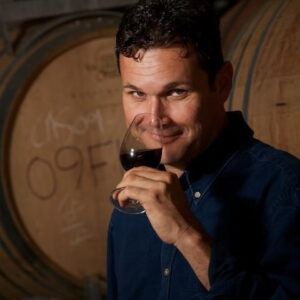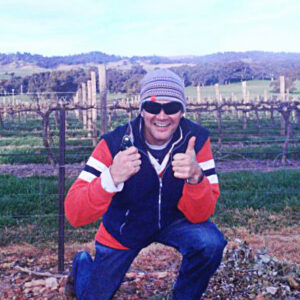A fortuitous placement in France during a high school exchange program proved to be a defining moment in Luke Bramon’s life.
“The family I stayed with was involved in wine, and the drinking age in France was 18, but no one paid attention to it, so I was very fortunate to learn about wine in a very historic setting and in a very traditional way,” said Bramon, now the founder of his own international brand, Luke’s Leap Wines; and an instructor in San Diego State University’s Business of Wine program. “The people in the village would take me out hunting, and whatever we brought back would be made into amazing meals, which magically highlighted the wines. When you consider that those wines and meals were experienced in 1000-year-old buildings, it made it even more sensational!”
Bramon answered some questions about his career and the courses he teachers at SDSU.
Please give us a brief history of your education and career.
I’ve been lucky enough to have worked and studied internationally. I have a master’s in wine business from the University of Adelaide in South Australia; and a master’s in public relations, geared toward wine media, from the University of Sydney. On the side, I managed to pick up certificates from the Court of Master Sommeliers and another from the Wine & Spirit Education Trust (WSET). What I’m most proud of is the hands-on work in the vineyard and winery. I’ll be coming up to my fifth harvest in California — and 11th when you include the wine crush/harvest worked overseas.
How did you come to be an instructor with SDSU’s Business of Wine program?
I was working in the wine industry in Paso Robles and absolutely loved it. But during the WiVi Central Coast Wine Industry Conference & Tradeshow, I met some people from San Diego wine country; they were so enthusiastic about what was happening with SD wine, that I became intrigued and started investigating the region. I contacted the SDSU Business of Wine Program and was very fortunate to get an interview and get hired!
What do you think are the biggest strengths of the program?
The biggest strength of the program is its innovative approach. You have a lot of instructors in the program, with international and statewide wine business experience, so students are getting a lot of current and relevant information from instructors with a broad range of skills and knowledge.
What’s are key takeaways from your courses Intensive: French Wines and Intensive: Burgundy Wines, and what kind of homework can students expect?
Since this is a wine business program, we’re looking at wine from a broader perspective. It goes beyond looking at the traditional French brands, which everyone gets taught. We also look at a lot of French wines that you normally wouldn’t think about. The point is to be able to know that there are now wines within France which are just as good, if not better, than the traditional high-priced and recognized brands. When students realize this, it gives them the confidence to go out and create a “cult wine list” by offering standout wines that most wine consumers would be unaware of. Because we’re dealing with wines that most students haven’t heard of or tried, most homework assignments include wine tasting and some food and wine matching. Unsurprisingly, no one’s ever complained about the homework. In the end, students’ final projects have included creating a cult wine list matched with a restaurant menu, or creating an innovative French wine sales list and marketing plan, which includes a sommelier’s approach to explaining why they’ve chosen these particular wines. [Editor’s note: Intensive: French Wines starts October 23 and registration is open.]
What’s a key takeaway from your Vineyard Management course, and how does the day unfold when you visit the vineyard?
With Vineyard Management, students learn to taste wine like a viticulturist — tasting to sense the natural aromas and flavors of the grape. Where before we were matching wine to food, now we’re matching wine grapes to soil and environment. There’s also a lot of marketing, cost, and vineyard planning involved in the course. Ironically, the financial cost and planning of a vineyard seem to be the most popular part of the course. Because vineyard management is a broad subject, it can be a bit overwhelming for first-time viticulture students to comprehend, but once we get out into the vineyards, it gives them a chance to see that there are various ways to manage a vineyard while managing the cost. The wineries/and vineyards change, sometimes they’re in Ramona, San Diego or Temecula — it all depends on who’s doing something exciting and innovative. The main takeaway from the day is that students get the chance to interact with active vineyard owners/managers and pick their brains on various thoughts and theories of creating and managing a vineyard aimed at producing premium wine grapes.
Do you have a favorite anecdote you share with students about any aspect of the wine industry or your adventures therein?
I always start each course by telling my students about my wine education, then I ask them how much I know — NOTHING! And I remind them that once they finish the course and get their certificate, they will be really smart to know — NOTHING! The exciting thing about the wine industry, especially wine business, is that it’s forever changing on a daily basis. If you want to be really successful in the wine industry, you’ll always be researching, studying, and investigating all the latest trends and using them to your advantage.
What do you enjoy most about teaching?
I love the enthusiasm and excitement of the students and I love being a part of their wine journey. When you see students actually start to “get” wine and understand what’s happening in that wine glass and why — it’s just as exciting for me to see them getting it, as it is for them to be getting it!
What are your top three favorite wines?
Oh, that’s a hard one! Brands change but I have favorite varietals, which usually remain the same — Syrah, Pinot Noir, Cabernet Sauvignon. At the moment, my favorite wine regions are Paso Robles and Santa Barbara — the central coast in general — a lot of innovative and exciting things are happening there right now!
What did you want to be when you grew up?
I wanted to be the quarterback for either the San Diego Chargers or SF 49ers (those were my two favorite teams). But by the time I got my communications degree from USC, I knew that wasn’t happening. I still thought I’d go into sports marketing, but by a fluke I wound up in wine marketing, absolutely loved it, and moved on to winemaking and viticulture. I love the industry and wouldn’t give it up for an NFL quarterback position.
What would students be surprised to learn about you?
I’m a volunteer with the United States Coast Guard Search and Rescue, which sometimes surprises people. But the most shocking thing would be — I’m fortunate enough to be surrounded by some of the best bottles of wine in the world, but during wine harvest I drink a beer at the end of the day.
Anything you’d like to add?
It’s an exciting time in for the San Diego wine industry. It’s starting to revitalize itself and is going to be growing over the years. There are going to be a lot of opportunities for those who have the skills and passion to drive the industry forward, and I’m happy that the SDSU Business of Wine program is helping to lead the way.






